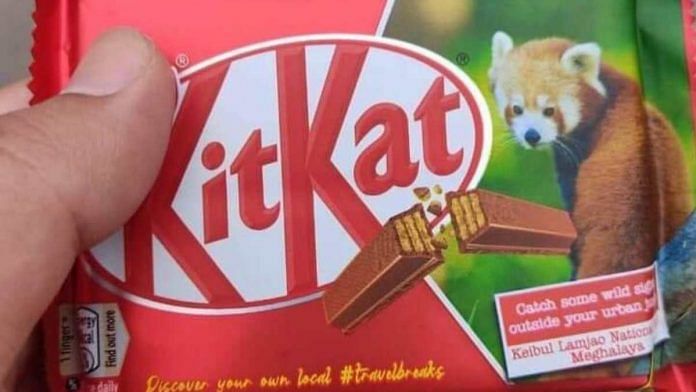New Delhi: The Manipur forest department has written a letter to FMCG major Nestle after a wrapper on its KitKat chocolate wrongly showed that Keibul Lamjao National Park is situated in Meghalaya.
Keibul Lamjao, the only floating national park in the world, is situated in the Bishnupur district of Manipur.
In a letter to Nestle Thursday, A.K. Joshi, principal chief conservator of forest (wildlife), Manipur, said, “I am writing to you to point out a serious factual error regarding one of your products.”
“We have come across a wrapping paper for KitKat chocolate which mentions the name of ‘Keibul Lamjao National Park’ but indicates its location in Meghalaya, which is grossly incorrect.”
Joshi also pointed out that the picture on the wrapper is that of a Red Panda (Ailurus fulgens), which is not found in the park.
Meanwhile, the People For Animals (PFA), Manipur, had warned that it will boycott all Nestle products if the misinformation was not rectified.
On Friday, Nestle issued an apology, saying it will bring out two new packs celebrating the beautiful locations of Manipur and Meghalaya.
Also read: For over 10 years, this Sikkim man has kept a lake litter-free at 12,406 ft
HIV+ woman from Mizoram helps over 10,000 patients
Vanlalruati Colney, a 37-year-old resident of Mizoram, has been helping persons living with HIV (PLHIV) in her state with timely delivery of food and medicines since nearly 14 years.
Colney, an HIV survivor, had established the Positive Women’s Network of Mizoram (PWNM) in 2007. It is a care and support centre for PLHIV in the state.
The organisation has so far helped over 10,000 people with counselling, legal assistance, treatment, rehabilitation, employment opportunities and food items.
“I volunteered in the field with no experience and qualification, but had one strong motive — I wanted to give them all my help in reducing their hardship and burden. I kept thinking, ‘If not me, then who?’,” Colney told The Better India.
A 39-year-old person associated with PWNM has been quoted as saying, “I was diagnosed with HIV in 2015, and found out about PWNM through social media. The organisation has helped me in many ways, especially with delivery of medication in a timely and confidential manner, so my family and community members are not made aware of my status.”
This Naga linguist is helping preserve local dialects
Sahiinii L. Veikho, who recently earned his Ph.D in linguistics from the University of Bern, Switzerland, has embarked on a project to bring out the first dictionary of Poula dialects. Poula is the language spoken by the Poumai Naga community in Nagaland and parts of Manipur.
Called the ‘Poula dialects dictionary’ project, it is a community-based initiative that was officially launched by the Poumai Literature Society recently.
The Poumai Naga Union has released a notification asking every village to collaboratively work and support the project.
Sahiinii had recently joined the Asufii Christian Institute in Punanamei, Manipur, as an assistant professor in the department of English. He has also initiated a project on developing a Mao language database. It is the language spoken by the Mao people, one of the major tribes constituting the Nagas.
This rare flower has been photographed after 73 years
A flower known as Strobilanthes recurva CB Clarke, commonly called the coneflower, has been photographed in the wild in Manipur after 73 years.
Belonging to the genus strobilanthes, the species was photographed near the Leimaram waterfall in the state’s Kangpokpi district by a team from the popular website, called Flowers of India.
The identification of the flower was confirmed by John R.I.Wood, an expert from the University of Oxford. Wood also said it was a rare species found in Northeast India and Bangladesh.
“This plant was last collected in 1948 from Manipur by F. Kingdon-Ward, who was also the observer of the famed Shirui Lily,” Tabish, the creator of Flowers of India, has been quoted as saying.
(Edited by Debalina Dey)
Also read: Tiger unit of Assam’s Manas National Park wins International Ranger Award



